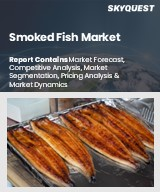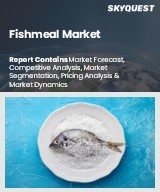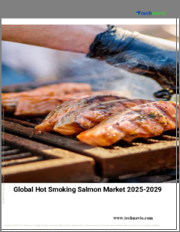
|
시장보고서
상품코드
1587699
세계의 연어 시장 예측 : 제품 유형별, 유통 채널별, 용도별, 지역별 분석(-2030년)Salmon Market Forecasts to 2030 - Global Analysis By Product Type, Distribution Channel, Application and By Geography |
||||||
Stratistics MRC에 따르면 세계의 연어 시장은 2024년에 673억 달러로 추정되고, 예측 기간 동안 CAGR 7.6%로 성장할 전망이며, 2030년에는 1,044억 달러에 이를 것으로 예상됩니다.
연어는 주로 북대서양과 태평양에 서식하고 연어과에 속하며 인기있고 영양가가 높은 물고기입니다. 핑크색에서 붉은 오렌지색의 특징적인 몸으로 알려진 연어는 그 풍부한 풍미 및 심장 건강과 전신 건강에 기여하는 오메가 3 지방산의 높은 함량으로 높이 평가받고 있습니다. 연어는 민물 지역의 강에서 바다를 왕복하는 매력적인 수명주기를 거쳐 독특한 맛과 식감에 영향을 미칩니다. 이 생선은 찜, 구이, 훈제, 초밥과 생선회로 생으로 먹는 등 요리의 용도가 넓습니다. 식용으로서의 매력뿐만 아니라 연어 어업은 많은 문화와 경제에서 중요한 역할을 담당하고 있으며, 야생 개체수를 유지하기 위해 지속 가능한 어법이 점점 우선시되고 있습니다.
2022년 유엔 식량농업기관에 따르면 연어를 포함한 세계의 양식어업 생산량은 2억 2,320만 톤에 이르렀으며 1950년 이후 높은 수준이 되었습니다.
온라인 쇼핑의 상승
온라인 쇼핑의 대두는 보다 폭넓은 소비자층에 대한 액세스를 확대하고 구매 프로세스를 합리화함으로써 연어 시장을 대폭 강화했습니다. 전자상거래 플랫폼을 이용함으로써 고객은 공급업체로부터 직접 신선한 냉동 연어를 주문할 수 있게 되어, 편리성이 확보되는 것과 동시에, 많은 경우, 종래의 소매점보다 유익한 가격으로 구입할 수 있게 되었습니다. 이러한 접근성의 편의성으로, 소비자는 유기농 및 지속 가능한 방법으로 조달된 것을 포함한 다양한 연어 제품을 검토할 수 있어 건강 지향과 환경 친화적인 선택을 요구하는 수요 증가에 부합합니다. 또한, 온라인 쇼핑은 연어의 세계 유통을 촉진하고 소비자는 세계 각지의 특산품을 즐길 수 있습니다.
양식의 과제
양식업은 세계 연어 수요를 충족시키는 데 필수적이지만, 지속가능성과 성장을 방해하는 몇 가지 심각한 과제에 직면해 있습니다. 큰 문제 중 하나는 바다고래 등의 질병과 기생충의 만연이며, 이러한 기생충은 물고기의 개체수를 파괴하고 비용이 많이 드는 개입이 필요합니다. 연어의 양식은 종종 사료를 천연 생선에 의존하기 때문에 남획과 서식지 파괴로 이어집니다. 수질과 폐기물로 인한 오염은 상황을 더욱 복잡하게 만들고 양식어와 그 주변의 수생 생물 모두에 영향을 미칩니다.
건강과 웰빙 동향
건강과 웰니스의 동향은 연어를 현대 식생활에서 슈퍼 푸드로 자리매김하고 그 매력을 크게 높여주고 있습니다. 소비자들이 영양가를 우선시하는 경향이 강해지면서 심장 건강을 돕고 염증을 억제하는 오메가 3 지방산을 많이 포함한 연어 수요가 급증하고 있습니다. 또한 지속 가능하고 윤리적인 식생활을 요구하는 동향도 중요한 역할을 하고 있어 많은 사람들이 천연물이든, 환경 친화적인 프랙티스 하에서 양식된 것이든, 책임을 가지고 조달된 연어를 선택하고 있습니다. 또한 식물성 식생활의 대두로 인해 포켓볼에서 지중해 요리까지 다양한 요리 스타일에 연어를 도입하는 것에 관심이 모여 있으며, 연어는 만능 식재료가 되고 있습니다.
가격 변동
연어 시장의 가격 변동은 생산자와 소비자 모두에게 큰 영향을 미치고 공급망에 불확실성을 가져다 줍니다. 연어 가격의 변동은 수요 변화, 환경 조건, 대체 수산물과의 경쟁 등, 다양한 요인에 기인합니다. 생산자에게는 예측 불가능한 가격 설정은 생산 계획이나 투자를 어렵게 하고 과잉 생산이나 물품 부족의 가능성을 초래합니다. 이 불안정함은 수익성에 영향을 미치고 소규모 생산자는 시장에 적응하거나 철수해야 합니다. 소비자 측에서는 가격의 변동은 구하기 쉽고, 사기 쉬움의 불안정으로 이어져 소비자를 보다 안정적인 수산물로 향하게 할 가능성이 있습니다. 가격 변동은 환율과 세계 경제 상황에 따라 국제 수요가 크게 변동하기 때문에 수출 시장을 혼란시킬 수 있습니다.
COVID-19의 영향
이동과 집회의 제한으로 인해 많은 상업 어업들이 조업 과제에 직면하여 어획량의 감소로 이어졌습니다. 가공공장은 위생규약 때문에 노동력 부족에 빠져 생산이 더욱 방해되었습니다. 게다가 레스토랑 폐쇄와 세계 관광객의 감소가 신선한 해산물에 대한 수요를 크게 저하시켜 가격 폭락을 초래했습니다. 이러한 경제적 변형으로 인해 많은 어업자들은 소비자에게 직접 판매로 축발을 옮기거나 어획량을 다양화함으로써 적응할 수밖에 없었습니다. 팬데믹 기간 동안 어획 압력의 감소는 일부 연어 개체군에 잠깐 사이의 휴식을 가져왔고, 특정 지역에서 회복의 가능성을 가져왔습니다.
예측 기간 동안 긴자케 부문이 최대가 될 전망
특히 생태적 균형과 어업의 지속가능성 측면에서 긴자케 부문은 예측 기간 동안 가장 큰 점유율을 차지할 것으로 예상됩니다. 선택적 번식과 서식지의 회복에 초점을 맞추어 이 노력은 생태계의 건전성과 지역 경제 모두에 필수적인 긴자케의 유전적 다양성과 탄력성을 향상시키는 것을 목표로 하고 있습니다. 은연어의 개체수를 늘리는 것은 산란의 성공과 유어 생존율의 향상으로 연결되어 결국 수생식물망 전체를 지원하게 됩니다. 게다가 책임있는 어업의 실천과 서식지의 보전을 추진하기 위해서 지역사회, 어업 단체, 보호 단체와 협력하는 일도 많습니다.
소매점 부문은 예측기간 중 가장 높은 CAGR이 예상됩니다.
소매점 부문은 지속가능하고 고품질 수산물 선택을 요구하는 소비자 수요 증가에 대응하기 위해 연어 카테고리 강화에 주력하고 있으며 예측 기간 동안 급성장할 것으로 추정됩니다. 소매업체는 책임있는 어업과 양식장과의 제휴를 우선함으로써 연어가 맛있을 뿐만 아니라 환경 친화적인 상품임을 보증하는 것을 목표로 하고 있습니다. 이 강화에는 공급망의 투명성을 높이고, 추적성을 중시하고, 해양관리협의회(MSC) 및 양식관리협의회(ASC)와 같은 인증을 추진하는 것이 포함됩니다. 소매업체는 신선도와 지속가능성을 강조하는 혁신적인 패키지를 도입하여 건강 지향 소비자들에게 호소하고 있습니다.
최대 점유율을 차지하는 지역
아시아태평양은 지속가능한 사례를 추진하고 식품의 안전성을 확보함으로써 추정기간을 통해 시장에서 가장 큰 점유율을 차지할 것으로 보입니다. 더 엄격한 환경 기준은 연어 양식에 의한 생태계에 미치는 영향을 완화하고 지역 생태계를 보호하는 책임있는 양식을 촉진합니다. 규제는 또한 추적성을 중시하고 소비자가 물고기의 원산지를 알게 함으로써 시장에 대한 신뢰를 높이고 있습니다. 사료의 품질 향상과 항생제의 사용을 줄이기 위한 노력은 보다 건강한 연어와 보다 지속 가능한 공급망에 기여합니다. 이러한 노력은 수출 가능성을 높여 지역 경제의 성장을 지원할 뿐만 아니라 윤리적으로 조달된 수산물을 요구하는 세계 수요에도 부합하고 있습니다.
CAGR이 가장 높은 지역
정부기관, 연구기관, 민간기업 등 이해관계자가 한자리에 모임으로써, 이러한 공동연구는 지식의 공유와 수산양식에 있어서의 베스트 프랙티스의 실시를 촉진합니다. 공동 연구의 이니셔티브는 번식 기술, 질병 관리 및 환경 지속가능성 개선에 중점을두고 생태계에 미치는 영향을 최소화하면서 연어 양식이 소비자 수요 증가에 부응할 수 있도록 합니다. 지역사회와의 파트너십을 통해 사회경제적 이익을 높이고 생계를 지원하는 책임있는 실천을 추진하고 있습니다.
무료 맞춤형 서비스
이 보고서를 구독하는 고객은 다음 무료 사용자 정의 옵션 중 하나를 사용할 수 있습니다.
- 기업 프로파일
- 추가 시장 진출기업의 종합적 프로파일링(3개사까지)
- 주요 기업의 SWOT 분석(3개사까지)
- 지역 세분화
- 고객의 관심에 응한 주요국 시장 추정, 예측 및 CAGR(주 : 타당성 확인에 따름)
- 경쟁 벤치마킹
- 제품 포트폴리오, 지리적 존재, 전략적 제휴별 주요 기업 벤치마킹
목차
제1장 주요 요약
제2장 서문
- 개요
- 이해관계자
- 조사 범위
- 조사 방법
- 데이터 마이닝
- 데이터 분석
- 데이터 검증
- 조사 접근
- 조사 정보원
- 1차 조사 정보원
- 2차 조사 정보원
- 전제조건
제3장 시장 동향 분석
- 서문
- 성장 촉진요인
- 억제요인
- 기회
- 위협
- 제품 분석
- 용도 분석
- 신흥 시장
- COVID-19의 영향
제4장 Porter's Five Forces 분석
- 공급기업의 협상력
- 구매자의 협상력
- 대체품의 위협
- 신규 진입업자의 위협
- 경쟁 기업간 경쟁 관계
제5장 세계의 연어 시장 : 제품 유형별
- 서문
- 송어
- 은연어
- 킹 연어
- 애틀랜틱 연어
- 태평양 연어
- 기타
제6장 세계의 연어 시장 : 유통 채널별
- 서문
- 소매점
- 슈퍼마켓 및 하이퍼마켓
제7장 세계의 연어 시장 : 용도별
- 서문
- 캔
- 생
- 냉동
- 기타
제8장 세계의 연어 시장 : 지역별
- 서문
- 북미
- 미국
- 캐나다
- 멕시코
- 유럽
- 독일
- 영국
- 이탈리아
- 프랑스
- 스페인
- 기타 유럽
- 아시아태평양
- 일본
- 중국
- 인도
- 호주
- 뉴질랜드
- 한국
- 기타 아시아태평양
- 남미
- 아르헨티나
- 브라질
- 칠레
- 기타 남미
- 중동 및 아프리카
- 사우디아라비아
- 아랍에미리트(UAE)
- 카타르
- 남아프리카
- 기타 중동 및 아프리카
제9장 주요 개발
- 계약, 파트너십, 협업 및 합작투자(JV)
- 인수 및 합병
- 신제품 발매
- 사업 확대
- 기타 주요 전략
제10장 기업 프로파일링
- Blumar SA
- Cremaq Group ASA
- Icelandic Group
- Leroy Seafood Group ASA
- Mowi ASA
- Ocean Beauty Seafoods
- SalMar ASA
- Sustainable Fisheries UW
- Trident Seafoods
- Walmart
According to Stratistics MRC, the Global Salmon Market is accounted for $67.3 billion in 2024 and is expected to reach $104.4 billion by 2030 growing at a CAGR of 7.6% during the forecast period. Salmon is a popular and nutritious fish belonging to the family Salmonidae, primarily found in the North Atlantic and Pacific Oceans. Known for its distinctive pink to reddish-orange flesh, salmon is celebrated for its rich flavor and high omega-3 fatty acid content, which contributes to heart health and overall wellness. Salmon undergoes a fascinating life cycle, migrating from freshwater rivers to the ocean and back, which influences its unique taste and texture. This fish is versatile in culinary applications, often grilled, baked, smoked, or served raw as sushi or sashimi. Beyond its culinary appeal, salmon fishing plays a significant role in many cultures and economies, with sustainable practices increasingly prioritized to preserve wild populations.
According to the Food and Agriculture Organization in 2022, the world's aquaculture including salmon fish and fisheries output reached 223.2 million metric tons, the highest level since 1950.
Market Dynamics:
Driver:
Rise of online shopping
The rise of online shopping has substantially enhancing the salmon market by expanding access to a wider consumer base and streamlining the purchasing process. E-commerce platforms allow customers to order fresh and frozen salmon directly from suppliers, ensuring convenience and often better pricing compared to traditional retail. This accessibility enables consumers to explore various salmon products, including organic and sustainably sourced options, aligning with the growing demand for health-conscious and environmentally friendly choices. Furthermore, online shopping facilitates the global distribution of salmon, allowing consumers to enjoy regional specialties from different parts of the world.
Restraint:
Aquaculture challenges
Aquaculture, while crucial for meeting global demand for salmon, faces several significant challenges that hinder its sustainability and growth. One major issue is the spread of diseases and parasites, such as sea lice, which can devastate fish populations and require costly interventions. Environmental concerns also arise from the high feed conversion ratios, as salmon farming often relies on wild-caught fish for feed, leading to overfishing and habitat destruction. The escape of farmed salmon into wild ecosystems poses risks to genetic diversity and local fish populations. Water quality and pollution from waste products further complicate the situation, affecting both farmed and surrounding aquatic life.
Opportunity:
Health and wellness trends
Health and wellness trends are substantially enhancing the appeal of salmon, positioning it as a superfood in modern diets. As consumers increasingly prioritize nutritional value, the demand for salmon has surged due to its high omega-3 fatty acid content, which supports heart health and reduces inflammation. The trend towards sustainable and ethical eating also plays a crucial role, with many people opting for responsibly sourced salmon, whether wild-caught or farm-raised under eco-friendly practices. Additionally, the rise of plant-based diets has prompted interest in integrating salmon into various culinary styles, from poke bowls to Mediterranean dishes, making it a versatile ingredient.
Threat:
Price volatility
Price volatility in the salmon market significantly impacts both producers and consumers, creating uncertainty in the supply chain. Fluctuations in salmon prices can stem from various factors, including changes in demand, environmental conditions, and competition from alternative seafood sources. For producers, unpredictable pricing makes it challenging to plan and invest in production, leading to potential overproduction or shortages. This instability can affect profitability, forcing smaller producers to adapt or exit the market altogether. On the consumer side, fluctuating prices can lead to inconsistent access and affordability, potentially driving consumers towards more stable seafood options. Price volatility can disrupt export markets, as international demand may vary dramatically based on currency exchange rates and global economic conditions.
Covid-19 Impact:
With restrictions on movement and gatherings, many commercial fisheries faced operational challenges, leading to reduced catch volumes. Processing plants encountered labor shortages due to health protocols, further hampering production. In addition, the closure of restaurants and a decline in global tourism drastically lowered demand for fresh seafood, causing prices to plummet. This economic strain forced many fishermen to adapt by pivoting to direct-to-consumer sales or diversifying their catch. The reduced fishing pressure during the pandemic offered a brief respite for some salmon populations, allowing for potential recovery in certain regions.
The Coho Salmon segment is expected to be the largest during the forecast period
Coho Salmon segment is expected to dominate the largest share over the estimated period, particularly in the context of ecological balance and fishery sustainability. By focusing on selective breeding and habitat restoration, this initiative aims to improve the genetic diversity and resilience of Coho salmon, which are vital for both ecosystem health and local economies. Enhancing Coho salmon populations can lead to better spawning success and increased survival rates for juvenile fish, ultimately supporting the entire aquatic food web. Additionally, initiatives often involve collaboration with local communities, fisheries and conservation organizations to promote responsible fishing practices and habitat conservation.
The Retail Stores segment is expected to have the highest CAGR during the forecast period
Retail Stores segment is estimated to grow at a rapid pace during the forecast period as it is focusing on enhancing the Salmon category to meet growing consumer demand for sustainable and high-quality seafood options. By prioritizing partnerships with responsible fisheries and aquaculture farms, retailers aim to ensure that their Salmon offerings are not only delicious but also environmentally friendly. This enhancement involves improving supply chain transparency, emphasizing traceability, and promoting certifications like Marine Stewardship Council (MSC) and Aquaculture Stewardship Council (ASC). Retailers are introducing innovative packaging that highlights freshness and sustainability, appealing to health-conscious consumers.
Region with largest share:
Asia Pacific region is poised to hold the largest share of the market throughout the extrapolated period, by promoting sustainable practices and ensuring food safety. Stricter environmental standards help mitigate the ecological impact of salmon farming, fostering responsible aquaculture that protects local ecosystems. Regulations also emphasize traceability, allowing consumers to know the origins of their fish, which enhances trust in the market. Initiatives aimed at improving feed quality and reducing antibiotic use contribute to healthier salmon and a more sustainable supply chain. These measures not only support the regional growth of local economies by boosting export potential but also align with global demand for ethically sourced seafood.
Region with highest CAGR:
Asia Pacific region is estimated to witness the highest CAGR during the projected time frame, by bringing together stakeholders such as government agencies, research institutions, and private enterprises these collaborations facilitate knowledge sharing and the implementation of best practices in aquaculture. Joint research initiatives focus on improving breeding techniques, disease management, and environmental sustainability, ensuring that salmon farming can meet rising consumer demands while minimizing ecological impacts. Partnerships with local communities help enhance socio-economic benefits, promoting responsible practices that support livelihoods.
Key players in the market
Some of the key players in Salmon market include Blumar SA, Cremaq Group ASA, Icelandic Group, Leroy Seafood Group ASA, Mowi ASA, Ocean Beauty Seafoods, SalMar ASA, Sustainable Fisheries UW, Trident Seafoods and Walmart.
Key Developments:
In October 2024, Trident Seafoods and Pacific Seafood have jointly announced an agreement in principle for Pacific Seafood to acquire Trident's processing facilities at Kodiak.
In August 2024, Walmart has added new product categories, omnichannel experiences and fulfillment solutions to its eCommerce platform for third-party sellers, Walmart Marketplace. Walmart Marketplace will also add a new omnichannel experience that will connect shoppers with local retailers through Walmart's digital channels and offer direct pickup and delivery from sellers' physical stores. This Walmart LocalFinds offering will launch this fall in Atlanta and Dallas before rolling out to other cities.
In April 2024, Walmart Launches bettergoods, a New Private Brand Making Elevated Culinary Experiences Accessible for All. Walmart's largest private brand food launch in 20 years, bettergoods makes quality, trend-forward and chef-inspired food approachable and affordable, with most items priced under $5.
Product Types Covered:
- Masu Salmon
- Coho Salmon
- Chinook Salmon
- Atlantic Salmon
- Pacific Salmon
- Other Product Types
Distribution Channels Covered:
- Retail Stores
- Supermarkets/Hypermarkets
Applications Covered:
- Canned
- Fresh
- Frozen
- Other Applications
Regions Covered:
- North America
- US
- Canada
- Mexico
- Europe
- Germany
- UK
- Italy
- France
- Spain
- Rest of Europe
- Asia Pacific
- Japan
- China
- India
- Australia
- New Zealand
- South Korea
- Rest of Asia Pacific
- South America
- Argentina
- Brazil
- Chile
- Rest of South America
- Middle East & Africa
- Saudi Arabia
- UAE
- Qatar
- South Africa
- Rest of Middle East & Africa
What our report offers:
- Market share assessments for the regional and country-level segments
- Strategic recommendations for the new entrants
- Covers Market data for the years 2022, 2023, 2024, 2026, and 2030
- Market Trends (Drivers, Constraints, Opportunities, Threats, Challenges, Investment Opportunities, and recommendations)
- Strategic recommendations in key business segments based on the market estimations
- Competitive landscaping mapping the key common trends
- Company profiling with detailed strategies, financials, and recent developments
- Supply chain trends mapping the latest technological advancements
Free Customization Offerings:
All the customers of this report will be entitled to receive one of the following free customization options:
- Company Profiling
- Comprehensive profiling of additional market players (up to 3)
- SWOT Analysis of key players (up to 3)
- Regional Segmentation
- Market estimations, Forecasts and CAGR of any prominent country as per the client's interest (Note: Depends on feasibility check)
- Competitive Benchmarking
- Benchmarking of key players based on product portfolio, geographical presence, and strategic alliances
Table of Contents
1 Executive Summary
2 Preface
- 2.1 Abstract
- 2.2 Stake Holders
- 2.3 Research Scope
- 2.4 Research Methodology
- 2.4.1 Data Mining
- 2.4.2 Data Analysis
- 2.4.3 Data Validation
- 2.4.4 Research Approach
- 2.5 Research Sources
- 2.5.1 Primary Research Sources
- 2.5.2 Secondary Research Sources
- 2.5.3 Assumptions
3 Market Trend Analysis
- 3.1 Introduction
- 3.2 Drivers
- 3.3 Restraints
- 3.4 Opportunities
- 3.5 Threats
- 3.6 Product Analysis
- 3.7 Application Analysis
- 3.8 Emerging Markets
- 3.9 Impact of Covid-19
4 Porters Five Force Analysis
- 4.1 Bargaining power of suppliers
- 4.2 Bargaining power of buyers
- 4.3 Threat of substitutes
- 4.4 Threat of new entrants
- 4.5 Competitive rivalry
5 Global Salmon Market, By Product Type
- 5.1 Introduction
- 5.2 Masu Salmon
- 5.3 Coho Salmon
- 5.4 Chinook Salmon
- 5.5 Atlantic Salmon
- 5.6 Pacific Salmon
- 5.7 Other Product Types
6 Global Salmon Market, By Distribution Channel
- 6.1 Introduction
- 6.2 Retail Stores
- 6.3 Supermarkets/Hypermarkets
7 Global Salmon Market, By Application
- 7.1 Introduction
- 7.2 Canned
- 7.3 Fresh
- 7.4 Frozen
- 7.5 Other Applications
8 Global Salmon Market, By Geography
- 8.1 Introduction
- 8.2 North America
- 8.2.1 US
- 8.2.2 Canada
- 8.2.3 Mexico
- 8.3 Europe
- 8.3.1 Germany
- 8.3.2 UK
- 8.3.3 Italy
- 8.3.4 France
- 8.3.5 Spain
- 8.3.6 Rest of Europe
- 8.4 Asia Pacific
- 8.4.1 Japan
- 8.4.2 China
- 8.4.3 India
- 8.4.4 Australia
- 8.4.5 New Zealand
- 8.4.6 South Korea
- 8.4.7 Rest of Asia Pacific
- 8.5 South America
- 8.5.1 Argentina
- 8.5.2 Brazil
- 8.5.3 Chile
- 8.5.4 Rest of South America
- 8.6 Middle East & Africa
- 8.6.1 Saudi Arabia
- 8.6.2 UAE
- 8.6.3 Qatar
- 8.6.4 South Africa
- 8.6.5 Rest of Middle East & Africa
9 Key Developments
- 9.1 Agreements, Partnerships, Collaborations and Joint Ventures
- 9.2 Acquisitions & Mergers
- 9.3 New Product Launch
- 9.4 Expansions
- 9.5 Other Key Strategies
10 Company Profiling
- 10.1 Blumar SA
- 10.2 Cremaq Group ASA
- 10.3 Icelandic Group
- 10.4 Leroy Seafood Group ASA
- 10.5 Mowi ASA
- 10.6 Ocean Beauty Seafoods
- 10.7 SalMar ASA
- 10.8 Sustainable Fisheries UW
- 10.9 Trident Seafoods
- 10.10 Walmart



















